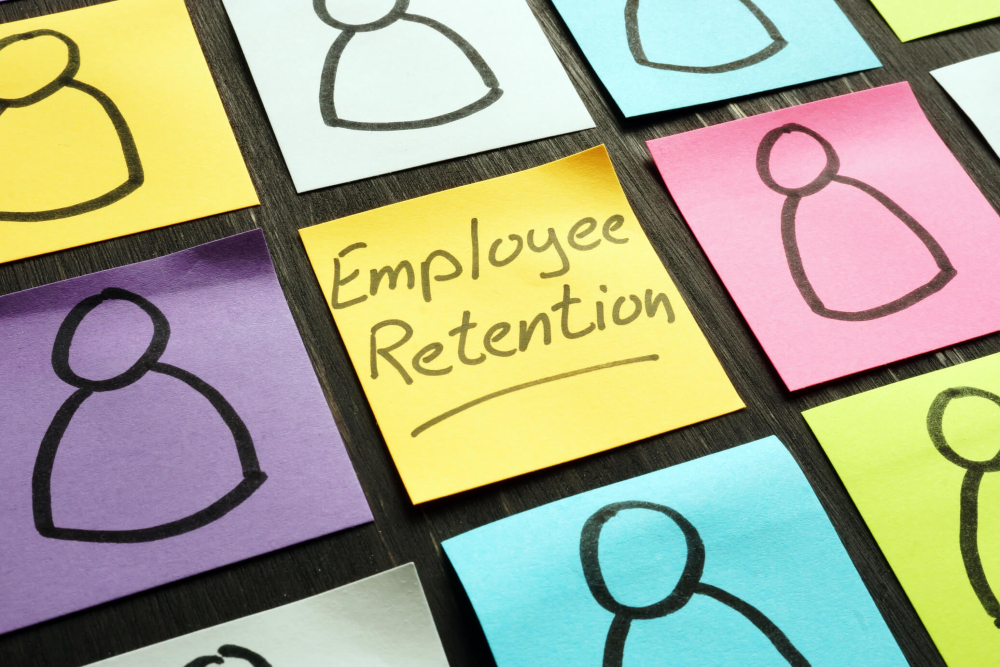
We previously took a look at the industries and new technologies that will thrive post-pandemic, as well as the current opportunities and outlooks that are driving demand for talent. It’s clear that most regions and industries are still remaining strong, with many parties cooperating to ensure that job opportunities will still be available. So, where are the likely key areas where the labour market might improve?
Here’s a list based on the estimates and projections of labour force in the World Employment and Social Outlook Trends 2022 report, by the International Labour Organisation:

One thing to keep in mind is that technology is among the key factors influencing the growing labour force. As noted by the World Trade Organisation in their presentation “Impact Of Technology On Labour Market Outcomes”, current technological advancement has resulted in a higher relative demand for skilled workers and a lower relative demand for workers performing routine tasks.
However, don’t forget that the tech and digital industries were among the hardest hit by the pandemic.
Like some other industries, the tech and digital industries experienced some eye-opening surprises as a result of the Covid-19 pandemic, but some detrimental repercussions could not be avoided. Before we recall the devastation that had befallen the tech and digital industries, let’s first look at the positive effects that would last for a very long time.
Many of us have grown accustomed to our working environment as more people receive the Covid-19 vaccine, borders have opened on a national and international level, and certain things have returned to their pre-pandemic state. However, because new coronavirus variants will continue to plague us, the fight against the pandemic is far from over.

The current state of the working world is also unstable because, as noted by the Harvard Business Review (HBR), this year’s level of volatility will rise as new variants continue to emerge, and many employees will experience real wage cuts as annual compensation increases lag inflation. These are all present, along with longer-term technological change, ongoing DE&I endeavours, and ongoing political upheaval and uncertainty.
The following five fundamental trends will affect workplace volatility in 2022:
Gartner HR Research reveals that 82% of employees report working environment lacks fairness. Unfairness will continue to be a hot button issue for many businesses as flexible, remote, and hybrid work models become more prevalent. There will be disputes among employees and inquiries from their superiors over who gets to work from home more frequently, who is more productive at work, and other related issues.
Many, if not most, employees in today’s workplace seek flexibility. Given that flexible scheduling is associated with lower employee turnover in organisations, it is safe to assume that the opposite will result in high turnover. Employers who don’t offer flexibility run the risk of losing employees to employers who do, increasing attrition risk as well.
Remote work is a great solution that has become popular for staying safe during the pandemic, but it presents employers with the conundrum of how to measure remote employee productivity. Their decision may cause friction between those who work from home and those who work in the office because, according to a Gartner November 2020 survey of nearly 3,000 managers, 64% believe that on-site employees perform better, and 75% believe that on-site employees are more likely to be promoted.
According to HBR, more than 90% of employees intend to use a hybrid working model for their knowledge workers in 2022. However, nearly halfway through the year, some companies have stated that they want their employees back in the office. As many as 58% of companies polled by Teamlease believe that work will be done entirely in-office in the future. Employees and management may clash as they adjust to the new working model.
In 2022, organisations will implement new measures to assess their employees’ mental, physical, and financial health, as mentioned by HBR. Following the pandemic, many businesses increased their wellness support. For example, a Gartner 2020 survey of 52 HR executives discovered:
Thus, employers must understand whether employees are taking advantage of the benefits and whether any of the benefits have assisted them in improving their well-being.
When coping with the new working environment that follows the pandemic, various viewpoints and approaches are available out there. Fortunately, a number of corporate leaders are voicing their views on the subject and wanting to assist employees in dealing with the new challenges. Check out some of their responses below:

“CIOs and IT leaders are trying to wrestle with, you know, ‘What’s the level of flexibility I give my workforce here? Can I let them have an Apple Watch Connect?’ Well, you probably should, because this generation considers that part of their productivity stack – a part of how they stay connected.”
He continued, “So you take all those conditions, and the data is clear. IT leaders are now going to have to manage this extreme flexibility and how they allow their workforce to connect and do their jobs. In fact, what I find compelling about the data is that it suggests they’ll sacrifice promotions and pay and positioning for flexibility.”

“For many companies, data will be part of day-to-day work and overarching strategy, if it isn’t already. This is especially true at Healr Solutions, which uses data to create solutions for biopharmaceutical supply chains. As we progress to the future, work will be heavily dependent on making decisions based on large datasets.”
He continued, “At Target, we use data-driven tools to support quicker, more effective decision making. The way of the future is using that information to improve speed and quality of service to meet guest expectations.”

“Bots offer a particular opportunity for highly regulated industries like health care that have codified activities. A bot can bring a quick solution, reducing the risk of human error and freeing up time for researchers.” She continued, “Amgen is thinking about existing skills and determining where gaps are, with an emphasis on involving employees in solutions.
She continued, “This includes explaining why changes are made and how more and new technology will benefit employees by helping them develop new skills and free up time. People are worried they’ll be replaced by technology and lose their jobs. This can be quickly addressed once individuals understand how these tools will help them perform better and more efficiently.”

“If you want to predict the future, you don’t look at big companies or older companies – you look at young companies, especially for [work] culture. Airbnb’s ‘work from anywhere’ model isn’t just forward-thinking, but unique in its approach to salaries, as almost everyone with flexible work policies still ties employees’ pay to their locations.”
He added, “The most talented people aren’t in San Francisco anymore, and they’re not here in New York. The most talented people are everywhere now – and if I need engineers, designers, product managers, or marketers, they’re getting so distributed that if you limit your talent pool to community radius, you’re probably at a disadvantage.”
Due to the pandemic, organisations from all sectors have changed how they operate, who they hire, what kinds of jobs they offer, and other aspects of their business. In just two years, many aspects of how people work have changed drastically. To avoid falling behind and maintain their competitiveness in the labour market, both employers and employees must quickly adapt.
Just as the World Economic Forum and Boston Consulting Group reported on some potential outlooks for the workplace of the future. These include elements like the rapidly expanding global workforce, extensive automation of employee tasks, a higher percentage of the workforce moving to remote positions and entrepreneurial endeavours, and a higher proportion of high-skill areas moving into high-skilled jobs.
What can employers do to help employees get ready? Making a workforce that is prepared for the future is the key. The BCG recommended the following actions for businesses to take, in order to meet the challenges of upskilling and future-proof their workforce while also ensuring employees are prepared to face any work challenges that come, especially in the future of work:

The pandemic has changed how people work, live, receive healthcare, and shop and these changes will boost demand for tech and digital occupations. Many people will be curious as to whether the situation will change back to how it was before the pandemic. But each of us needs to keep moving forward and take the necessary actions to adapt to what is happening right now and in the future in this quickly changing, constantly evolving world.
The ongoing pandemic and economic uncertainty make the future unpredictable. In some industries, there may be more open positions, while in others, there may be more layoffs. Employees may reduce working hours or work from home full-time, but it is also possible to do the opposite. There are a lot of potential changes, but here are some predicted by Gartner for the workplace over the next ten years:
If you’re looking for more about the future of a post-pandemic world, why not check out our other article coverages:
1) Pandemic-Rebound Part 1: Which Industries/New Technologies Will Thrive And See A Rise In Hiring?
2) Pandemic-Rebound Part 2: What Are The General Outlooks And Opportunities From Around The World?

There’s no doubt that the Covid-19 pandemic has wrecked havoc of unbelievable proportions: Economic and geopolitical systems weakened, high commodity prices, inflation, as well as disruptions to the international trade and supply chains. Despite all of that, countries have done their best to overcome the hard-hitting impacts to their economies, in addition to proving how resilient they are in different settings. However, even with plenty of recovery practices in action, many experts fear that a global economic recession is on the horizon.
Apart from that, the world of work has changed dramatically across all industries, and nearly all have invested in a digital way of doing business. Thanks to each country’s efforts to get back on their feet, job opportunities still abound in various parts of the world, especially for those who possess the necessary knowledge and skills, as well as the courage and mindset to explore and rule new dimensions.
This is consistent with the findings of the Project Management Institute’s (PMI) 2021 Talent Gap report, which estimates that by 2030, the world will require 2.3 million additional project management professionals annually to keep up with demand. Adapted from the PMI 2022 Jobs Report, let’s take a look at the current opportunities and outlooks that are driving demand for project leaders by region:
| Region | The Outlook | The Opportunity |
| Asia Pacific | This part of the world is a manufacturing powerhouse that has fueled economic growth by capitalising on international demand for its goods. Exports have been increasing in the region until pandemic-related setbacks. For instance, Japan’s growth rate decreased by an estimated 0.8% when the country’s Covid-19 cases increased in late 2021, leading to lockdowns. Additionally, the IMF significantly cut its growth projection for the Asia-Pacific region in October compared to earlier projections, citing the region’s uneven policy support and slow vaccination coverage. Nevertheless, all indicators point to growth in the coming year. In contrast to South Korea’s projected growth of 2.7%, Australia’s economy is projected to expand by 3.5%, New Zealand’s by 3%, and Japan’s by 2.3% in 2022. | Although exports may be the main driver of economic growth in the region, hiring is not the only encouraging trend. According to market research company Mordor Intelligence, fintech is booming in the area and is predicted to grow by 16% annually through 2026. Throughout the pandemic, Australia had remarkably low rates of job switching, but this is now changing as the inflow of project talent from abroad has decreased due to border closures brought on by Covid-19. Despite the worst hiring outlooks for Q1 2022, employers in all 40 countries surveyed expressed optimism. Construction, healthcare, government, and social work all face potential contractions, but banking, finance, IT, and telecom show encouraging hiring sentiments. |
| China | The IMF predicts that the second-largest economy in the world will see GDP growth slow from 8% in 2021 to 5.6% in 2022. According to the Oxford Institute for Energy Studies, the nation is experiencing an energy crisis due to record-high coal and natural gas prices, which may hinder the government’s ambitious plans to transition to renewable energy sources. Also, one of the biggest worries is China’s highly indebted real estate market. Meanwhile, the Chinese government unveiled a five-year plan to increase employment and wage growth in light of the nation’s anticipated record 9.1 million new workers in 2017. By 2025, 55 million new urban jobs must be created to keep the official urban unemployment rate at 5.5%. There are signs that project activity will pick up in the interim. | China’s finance ministry committed CNY1.55 billion to wind farms, CNY2.28 billion to solar power plants, and CNY38.24 million to biomass power generators, in November. The need for project leaders is then anticipated to increase due to China’s energy transition plan and the requirement to prepare for climate change risks. Private businesses also want to intensify their sustainability efforts. According to Karl Fjellstrom, managing director of Far East Mobility in Guangzhou, local eco-friendly transportation initiatives will spur demand for project talent. In addition, the pandemic is boosting opportunities in the pharmaceutical industry, particularly for biologic medicines, and there’s a sizable market for project management and technical personnel. |
| Europe | The European Union’s economy is strengthening, with 2021’s end-of-year GDP growth expected to be 5.2%. The OECD anticipates that the GDP of the eurozone will increase by 4.3% this year and that unemployment rates will return to pre-epidemic levels, barring unanticipated issues from other Covid-19 variants. But supply chain problems, particularly in the transportation and construction industries, have exacerbated bottlenecks and slowed manufacturing efforts. Growth and job gains will be restricted until pricing and supply chain disruptions are stabilised due to the ensuing spike in inflation, which will be 5% in December 2021. Several nations are taking actions to encourage project funding and spur job growth over time to lessen the effects of disruptions in Europe’s energy supplies and unrelated spikes in natural gas and electricity prices. For instance, the United Kingdom enacted a two-year “super deduction” tax break, while France’s 2030 plan will invest €30 billion over the following five years in a variety of commercial sectors. | A record-breaking US$121 billion was invested in European technology in 2021, more than tripling the amount invested the year before. The rapid rate of pandemic-driven digitisation, combined with this investment and the IT industry’s attempt to fill a talent gap, have created the ideal IT opportunities for project professionals. In many industries, like transportation and construction, where project leaders are required to promote innovation while minimising risk, there’s a shortage of labour. This shortage, coupled with supply-chain disruptions, has led to an increase in demand for project professionals in these sectors. The need for project managers for renewable energy sources is being fueled by the rising price of fossil fuels and the increasingly ominous climate predictions. As part of his France 2030 plan, President Macron has also set aside €8 billion for energy initiatives, intending to lower greenhouse gas emissions and becoming a global leader in green hydrogen. |
| Latin America | Despite having a GDP growth rate of 6.3% in 2021, this region is only anticipated to grow by 3% this year. This is due to a widespread and historic drought crippling the hydroelectric generation in Latin America, which once provided the majority of Brazil’s electricity. Governments are now relying on imported natural resources as energy prices globally soar. The presidential elections scheduled this year in Chile, Colombia, Costa Rica, and Brazil, also have a history of disrupting the economy. There are some encouraging signs amidst the fear and uncertainty, even though employment levels in many Latin American countries are still significantly below their pre-epidemic levels and inflation is rising fast. Critical projects in Latin America will be financed by the Build Back Better World global investment initiative, which the G7 group of major industrialised economies launched in June. | According to Elton Soares, PMP, lead project manager, GE, Santa Cantarina, Brazil, companies are constantly trying to adapt, so project professionals who are knowledgeable about the latest developments are needed. And anyone who can assist businesses in navigating the pandemic and the emergence of AI is in a good position to advance their careers. While there are opportunities in all industries, the manufacturing and technology sectors have the most open positions for project managers. There are more IT job openings than qualified candidates, based on the study published in late 2021 by Brazil’s Softex. In 2022, 400,000 IT positions, according to Softex, are expected to be vacant. Opportunities in technology aren’t just limited to conventional IT. To remain relevant for digital consumers, healthcare, retail, education, and financial services are becoming more and more entwined with technology. To stand out to hiring managers, job candidates should highlight any agile experience and professional certifications. |
| Middle East & North Africa | In 2022, the Middle East and North Africa should see a reduction in the economic damage caused by the pandemic and falling oil prices, opening the door for another round of the region’s famed high-profile megaprojects. Given the rapid Covid-19 vaccination campaigns and government spending initiatives related to the pandemic, the IMF increased its economic growth projection for the region to 4.1%. Late in 2021, oil production grew significantly, and prices climbed to their highest level since 2014. The World Travel & Tourism Council reports that tourism is also on the rise, with growth expected to reach about 27% in 2021. Even though those figures are below the average for the world, Expo 2020 Dubai may help increase them, as the emirate reported receiving more than 1 million foreign visitors in just a month of October. The hospitality industries in Qatar and Bahrain were severely impacted by the pandemic as well, but they report encouraging increases in tourist spending and travel in late 2021, largely due to Qatar hosting the FIFA World Cup in 2022. | All indications are that project activity and job opportunities will pick up as core industries recover. For instance, it’s anticipated that construction spending will surpass US$110 billion for the second year in a row in the six-nation Gulf Cooperation Council. Moreover, Saudi Arabia and the United Arab Emirates (UAE) are predicted to be at the forefront of the field thanks to their diverse portfolios of residential, mixed-use, commercial, and touristic buildings, as well as their energy and infrastructure projects. Long associated with fossil fuel energy, the Middle East and North Africa are now home to several renewable energy projects, such as the Al Dhafra Solar Photovoltaic Plant in the United Arab Emirates. And BP recently announced plans to build multiple gigawatts of renewable energy and green hydrogen projects in Oman by 2030. Project managers must still adjust to pandemic-driven changes that redefine “business as usual” even as the economy begins to recover. Additionally, there’s a demand for project talent in developing research areas like software engineering. These research teams will require more members who can create procedures and frameworks. |
| North America | Despite of supply-chain bottlenecks, a talent shortage, and worries about Covid-19 variants, growth in the United States and Canada is anticipated to continue. This year, the IMF predicts that the GDP of the United States will rise by 5.2% and that of Canada by 4.9%, both of which are 0.8 percentage points less than in 2021. The ability of government officials to control inflation will also determine how quickly and effectively the economy can grow. Even though the Great Resignation movement may be currently centred in the United States, the unemployment rate fell to 3.9% in November, the lowest level since Covid-19 first appeared. Three million American workers left their jobs during the pandemic, and many businesses are having trouble getting them back. Many businesses are increasing salaries to combat rising inflation and a lack of qualified workers. The Conference Board conducted a survey, and the results show that businesses are budgeting an average of 3.9% of payroll for wage increases in 2019—the highest level since 2008. | Because there are so many opportunities in the United States, job seekers can generally indulge in the luxury of being picky. The sectors expected to hire massively are manufacturing, professional and business services, transportation, and construction. The healthcare industry is also flourishing. The auto industry and other segments of the manufacturing sector in Canada have been slowed by supply-chain disruptions. As a result, there will also be a high demand across all industries for project managers who can proactively identify, manage, and reduce the risks associated with supply-chain bottlenecks. The need for changemakers who can lead these transformations will grow as organisations move further toward automation and digitisation as a result of hiring and logistical issues. In the first half of 2021, the declining foreign investment made it difficult for Canada’s mining, agriculture, manufacturing, and energy sectors to thrive. The Conference Board of Canada, however, predicts that as exports rebound in 2022, there may be a corresponding rise in demand for talent in those industries. |
| South Asia | The demand for goods has only grown over the last two years, and India’s significant contribution to the electronics supply chain is anticipated to contribute to the nation’s 8.3% growth this year. However, the disparities in South Asia’s economies continue to be enormous. Each nation’s economy has been influenced by different levels of tourism dependence, extreme weather events, and Covid-19 containment strategies. The pandemic’s uneven effects have been felt not only along geographic lines but also along gender lines. According to a 2021 study from Azim Premji University, among Indians who lost their jobs during the early-2020 lockdown, nearly half of women had trouble finding new employment, compared to just 7% of men. Inequities for women and unskilled workers have only grown worse as a result of the pandemic. The World Bank’s most recent statistics show that from late 2020, just 16.1% of workers were women, down from a peak of 26% in 2005. | It’s not surprising that the IT industry in India continues to offer many job opportunities, especially in light of the significant push for digitisation across industries. Many new IT projects have become available as a result of the rapid pace of digitisation in both internal and customer-facing operations. In the meantime, a survey by Willis Towers Watson predicts that salaries in India will increase by almost 9% in 2022. Companies are more willing to spend more on project managers who have an entrepreneurial mindset, can affect culture change, and can form enduring, effective teams. Another booming industry is telecom. The Naukri JobSpeak Report indicates that between November 2020 and November 2021, hiring activity in the industry increased by 91%. Additionally, professionals with eight to twelve years of experience were in high demand across all industries. Another promising sector is telecom. The hiring activity in the industry increased by 91% between November 2020 and November 2021, according to the Naukri JobSpeak Report. The most in-demand professionals across all industries were those with 8-12 years of experience. |
| Sub-Saharan Africa | The GDP growth predicted for this region’s economy in 2022 is expected to be 3.8%, or almost equal to the gains from the previous year. However, that regional rate obscures the fact that different nations are experiencing unequal growth. For instance, growth in Ghana and Kenya is anticipated to be at least 6%, compared to much more modest growth forecasts for Nigeria (2.7%) and South Africa (2.2%). The two main factors influencing global trade and commodity price increases are growth in general. However, low Covid-19 vaccination rates keep limiting project potential. The World Health Organisation reports that only 6% of the population in Africa had received Covid-19 shots as of late 2021, making it the region with the slowest vaccination rollout worldwide. | Sub-Saharan Africa is looking toward much-needed infrastructure upgrades, many of which are supported by government assistance, despite challenges brought on by pandemics. Various projects, such as upgrades to water supply systems, government-subsidised housing, and student housing, have been launched in South Africa with the assistance of a US$7 billion fund of private and public investments. Around US$32 billion of global aid are spent in Africa, which is fueling the creation of new development jobs there, up to 45% of which will require project talent. Project management hiring will increase as a result of the growing demand in development organisations to show accountability and results. The need for project managers who can support teams in delivering proactive and sustainable solutions is also being driven by climate change. |
If you’re looking for more about the future of a post-pandemic world, why not check out our other article coverages:
1) Pandemic-Rebound Part 1: Which Industries/New Technologies Will Thrive And See A Rise In Hiring?
2) Pandemic-Rebound Part 3: What Are The Long-Term Impacts And Newest Trends We Can Expect?

What legacy will Covid-19 leave in a world that has changed drastically, but is more resilient? The effects of the pandemic, which resulted in many lives lost and countless people losing their jobs due to its rapid and unchecked spread, are still very much felt to this day.
While employment began to recover months later, it remained high throughout 2020. Nevertheless, many industries continue to view the pandemic as a blessing in disguise. Companies took all the necessary measures to ensure business continuity and survival, as the entire world worked to contain the pandemic. It has fundamentally altered how people interact with one another, and has sparked unheard-of changes in every sector of the global economy.
The pandemic ushered in a period of opportunity for new industries to develop and shape consumer behaviour for decades to come, much like previous recessions.
While some already-existing industries will likely struggle to survive, some will flourish as they are compelled to transform, reorganise, and evolve to fit the new norms. Just consider how many things, including workouts and school classes, became available online in the aftermath of the outbreak.
According to a CBINSIGHTS Research Report, the following are some of the industries and technologies poised to thrive and shape the post-Covid world.

Due to overcrowded hospitals and the risk of infection, patients and healthcare professionals were forced to quickly adopt telehealth services and remote health monitoring. McKinsey reported that from July 2021, telehealth services were used 38 times more frequently than they were before the pandemic. VC firms jumped on this trend quickly, and invested three times as much money in digital health startups in 2020 compared to 2017.
Telehealth technology, continuous and remote diagnostics, remote mental healthcare, virtual fitness, plus aging-in-place technologies may all continue to develop as infrastructure advances and these services become more widely known. This could be true even after the pandemic has ended.
People have been confined to their homes as a result of social isolation policies, making remote work and workplace flexibility trends necessary. Many businesses were forced to make the switch from traditional office work to remote work. Employers and employees thus utilised technology, such as virtual reality and video conferencing apps like Zoom and Microsoft Teams, to balance productivity with overall well-being.
Due to the explosive growth in demand for its services in 2020, Zoom’s share price increased by almost 400%. As a result, tech firms have seen unprecedented network stress, and a massive demand for their services. The new workplace norm is thought to be here to stay, even after the pandemic has passed, because businesses across all industries had to adjust to the difficulties of a suddenly dispersed workforce.

The Covid-19 outbreak had an impact on the $96.6 billion fitness sector. Over 350,000 fitness instructors and trainers in the United States alone were forced to switch to virtual classes. Many of them have adapted by using already-available video-streaming services like Zoom, Instagram Live, FaceTime, and YouTube that weren’t necessarily designed for the purpose. According to ClubIntel, 72% of fitness club owners now offer on-demand or live-streamed workouts, up from just 25% in 2019.
Even though many gym-goers are content with their new home gyms, physical fitness may experience a rebound as the Covid-19 crisis passes. One appealing feature of in-person fitness is the routine of going to the gym for spin classes or other workouts, but it’s more than that. However, a hybrid model of at-home and in-person workouts is probably here to stay due to the added convenience of virtual fitness, and the lower cost of digital classes compared to those in studios.
Before the start of Covid-19, it was anticipated that the market for enterprise VR hardware and software would reach a value of $12.6 billion by 2025. For years, businesses have been figuring out how to use the technology. In the early fall of 2021, Facebook released a beta version of Horizon Workrooms, a VR remote control app. This release represented the next stage of this shift. The app allows Oculus Quest 2 VR headset users on Facebook to present themselves as avatars during virtual meetings.
The implementation of social distancing laws and the widespread adoption of remote work has given VR tech companies the chance to prove their value to businesses in unforeseen situations. Additionally, VR has supported business operations across a variety of sectors. Social distancing indicates that many in-person tasks can be carried out safely, effectively, and at scale in the virtual world, suggesting that virtual reality may one day become a constant part of enterprise infrastructure.

Long before the pandemic, analysts predicted that schools and universities would value the edtech market at $350 billion by 2025 as a result of updating their infrastructure to include digital alternatives to the traditional classroom. Covid-19’s arrival, however, compelled a much faster expansion. During the height of the pandemic, remote learning technology and online courses filled the demand. However, the widespread return to in-person learning in the US was a sign that remote learning is likely to remain a backup option in most circumstances.
Even after the virus has passed, schools and universities will probably still use digital learning infrastructure as it advances, because there’s plenty of room for improvements. While this is going on, tech behemoths like Microsoft and Google will keep funding their initiatives in the field of education, leveraging their existing connections with parents, teachers, and administrators who use their products.
The coronavirus pandemic has revealed how vulnerable the manufacturing and logistics sectors are to a sudden, widespread disruption in human labour. Businesses are likely to take action to protect themselves from similar disruptions in the future. To reduce the industry’s reliance on human labour and aid manufacturers in adapting to shifting market conditions, this is likely to include increased investment in adaptable, scalable, automated solutions. Particularly well-positioned to speed up that evolution are automation and 3D printing.
When it comes to adapting to rapidly shifting demand, 3D printing technology has proven to be flexible and adaptable. For instance, Stratasys, the company that owns the popular 3D printer brand MakerBot, partnered with Massachusetts General Hospital to co-sponsor an innovation contest for the creation of printable ventilators. Besides converting its facilities to support the production of emergency medical supplies, UNYQ, a company that creates 3D-printed prostheses for amputees, did the same. The value of 3D printing for rapid prototyping will also drive increased adoption in sectors like manufacturing, automotive, and robotics, which together make up a $63 billion global market.
On the other hand, automation represents a long-term change in how businesses conduct themselves and is not a band-aid. According to the consensus of industry analysts at CB Insights, it represents a $337 billion global market. The organisations that take action to further automate their business processes during the crisis will probably keep doing so after it has passed, and adoption will spread beyond them as other businesses automate to keep up.

Although Covid-19 may have exposed the flaws in the just-in-time logistics strategies favoured by many supermarket retailers, it has also given businesses new opportunities to strengthen those weaknesses. Due to the pandemic, there’s now an unheard-of demand for online grocery delivery services, with many customers making their first purchase (and more!). Both regional chains and independent stores have had difficulty keeping up. In areas particularly hard hit by Covid-19, like New York City, orders that used to take hours to complete are now taking weeks.
Larger retailers like Amazon and Walmart will probably increase their market share in the future by enhancing the online grocery shopping experience with technological advancements like 3D product renderings, as well as customer service enhancements and quicker delivery times. At the same time, the pandemic has compelled businesses to invest heavily in their online operations, and the momentum that virtual commerce is gaining appears likely to last into a post-virus era.
Many customer support teams have found themselves fielding a noticeably higher number of calls from customers with inquiries about return and cancellation policies, store closures, and other topics in addition to fulfilling orders and processing sales. Businesses that use conversational artificial intelligence (AI) and cloud-based call centres may be better able to navigate the post-Covid-19 world than those that rely on face-to-face interactions; this dichotomy is likely to further divide the service economy in the years to come.
Many retailers have embraced chatbots as a component of larger social media engagement strategies because they understand the value of meeting customers where they are. For example, H&M and Sephora have introduced conversational agents on Kik, while brands like Burberry and Tommy Hilfiger have introduced their chatbots on Facebook Messenger.
As the number of online orders rises and consumers look for new ways to buy goods and services online, companies like fast food chains, governments and local authorities, as well as health organisations, may come to rely more heavily on conversational agents in the future. The quality of the information consumers can access and the simplicity of interaction will be chatbot developers’ greatest competitive differentiators in the post-Covid-19 world.

Many businesses have switched from using physical offices to cloud-based solutions for their call centre operations over the past ten or so years. The pandemic largely disrupted call centres that were still located on-site. An example would be Verizon that was forced to halt operations at its call centres in Wilmington (North Carolina) and Elgin (South Carolina) in March 2020 after staff members tested positive for Covid-19.
Cloud-based call centres have grown to be a popular choice for businesses looking to keep up support operations in the face of physical distancing policies. The collaboration between Amazon Web Services (AWS) and ServiceNow to offer an AI-driven “contact center-as-a-service” product suggests that these services may become more common even after the pandemic, as more businesses seek to lower their support costs while maintaining or raising current levels of customer care.
When social segregation became mandatory everywhere, fintech had a chance to convince users that it was worthwhile to entrust an app with their money. Despite of this, regulation will have a big impact on how opportunities in the fintech sector develop in the post-Covid era.
In the wake of Covid-19, public opinion has drastically changed in favour of contactless payment methods. According to surveys, a growing number of consumers view contactless payments as a fundamental requirement for products. Businesses are already responding to consumer demand, quickly implementing contactless payment methods in grocery stores, restaurants, and other critical establishments.
Additionally, branchless banking presents a sizable enough market opportunity for fintech to start providing banking services. High-yield savings and checking with ATMs were two of the cash-management products that Robo-advisor Betterment unveiled in October 2019. Acorns, a micro-investing app, adopted a similar strategy in May 2020 and expanded its lineup of retirement and investment products to include a Spend Account. Whatever the case, it’s likely that digital financial services will continue to grow after lockdowns are lifted given the convenience and security they provide.

Many customers were looking for virtual simulations of entertainment events like concerts and events, gaming leagues, and food festivals when venues closed and large gatherings were temporarily prohibited with the emergence of Covid-19. Most live events were completely cancelled, and many that offer virtual tickets in addition to in-person passes have moved to online only.
Some events have employed cutting-edge strategies to host virtual events and increase their online event programming to avoid losing additional revenue. For instance, in April 2020, organisers staged a virtual version of the Grand National horse race in the UK using computer graphics and sophisticated algorithms. Legislative meetings are also increasingly taking place virtually. The UK’s lawmakers also held the first-ever “Parliament via Zoom” in the same month, which was the first time in more than 700 years that Parliament had not convened in the House of Commons.
However, since many event organisers are unable to charge the same fees for virtual events, the necessity of virtual events may have a long-term effect on event revenues. Nevertheless, AnyRoad reports that event organisers anticipate raising their spending on online experiences by 58% in the future. Future improvements for event planners include crisis management, contractual knowledge, and a new set of marketing and technology skills.
Budgets for cybersecurity are rising as more people are now required to work online. This is because the widespread use of remote work has exposed security system flaws in organisations. Separately, long-standing innovations in data privacy and surveillance technology are regaining attention.
Although cyberattacks are a constant in the online world, they have increased significantly since the Covid-19 pandemic, sometimes by more than three times month to month. Nowadays, a large portion of the world works remotely online; there’s a growing demand for online delivery and shopping services; online streaming services are the preferred method of entertainment. These points of entry give cybercriminals more opportunities to locate vulnerable targets.
Security issues surrounding these applications will probably continue as distributed work and education become more prevalent in everyday life following the Covid-19 crisis. Businesses are more likely to implement strict corporate security and compliance structures to accommodate more remote workers. The Global Cyber Security Market was estimated to be worth $140.12 billion in 2021, and it’s anticipated to grow to $423.56 billion by 2028.

This technology became a crucial tool for containing the spread of the virus. Given the seriousness of the threat, there has been a shift in public opinion toward the incorporation of surveillance technology into daily life, provided that it aids in detecting and reducing the spread of the virus. It’s anticipated that The Global Video Surveillance Market will grow from $40.1 billion in 2020 to $81.3 billion by 2028.
Technology behemoths have also combined efforts to track people’s movements. Google’s Covid-19 tracker uses information from users’ mobile phone locations to examine how movements within communities have changed as a result of the pandemic. The Exposure Notifications System for Android and iOS, which was jointly developed by Google and Apple, ensures easy contact tracing on mobile devices.
Several camera manufacturers have asserted that their infrared and thermal imaging cameras are capable of detecting fever, aiding in the post-Covid-19 world’s need for the screening of sick people. Some experts predict that thermal imaging cameras will continue to be used, even after the pandemic is over, including for surveillance purposes unrelated to health.
Since funding and technological advancements have increased awareness of the market, food delivery has already experienced a surge in popularity. Last-mile food delivery has also been steadily gaining media attention. The Covid-19 crisis has only accelerated the rise of various delivery services to the point where they are now an essential aspect of customers’ lives.
Between March 2020 and March 2021, delivery orders in the US increased by 142% and carryout orders by 130%. On the other hand, cloud kitchens (also referred to as dark kitchens, virtual kitchens, or ghost kitchens) are eating establishments that accept orders and deliver them without allowing customers to eat in. Demand for food delivery from these cloud kitchens has increased as a result of Covid-19’s requirement that people stay at home.
If you’re looking for more about the future of a post-pandemic world, why not check out our other article coverages:
1) Pandemic-Rebound Part 2: What Are The General Outlooks And Opportunities From Around The World?
2) Pandemic-Rebound Part 3: What Are The Long-Term Impacts And Newest Trends We Can Expect?

‘We’re all in this together
And it shows
When we stand
Hand in hand’
– High School Musical
You’ve probably heard or sang that song, and yet when it comes to our work, it doesn’t seem the same way like in work-related movies. Search the phrase ‘office discrimination’ on Twitter and there would be an abundance of Twitter users sharing their horrid experiences of persecution based on gender, race, and/or religion.
It was once thought that these discriminatory practices were well past its heyday, but these things can and do still exist subtly in office premises all over the globe.
It may be in the form of an unwelcomed joke about one’s race, or an uninvited compliment to a woman which may just be bordering on an incident of sexual harassment.
The thing is, while companies chase their employees for things like hard work and even more time, incidents such as the above aren’t only offensive, but can affect their motivation. It’s not all bad news though, especially given that companies can take steps to ensure their workplace(s) is a safe space for people from all walks of life.
With the rise of social media, discourse over topics like ethnicity and gender issues have taken centre stage, with buzz words such as ‘inclusivity and diversity’ used interchangeably. But if you’re in human resources looking to rid your office of discrimination and prejudice, it’s best to know the difference between these two terms.
Starting with diversity, in the context of the office, this would mean creating a space featuring employees with various backgrounds that could include race/ethnicity and gender/sexual minorities, and even those who may be physically or mentally challenged.

But accepting talent from all walks of life is only the first step. You wouldn’t want a diverse office where those from minority groups don’t feel safe. This is where inclusion comes in. Basically, these would be instances where minorities feel included in the office. Inclusivity allows for everyone to be involved, to voice their opinion, and to be heard. That counts now, more than ever.
Dr. Robert Sellers, chief diversity officer at the University of Michigan, explains it succinctly: “Diversity is where everyone is invited to the party; equity means that everyone gets to contribute to the playlist; and inclusion means that everyone has the opportunity to dance.”
In essence, if you don’t include people, even diverse groups, that just results in a toxic work environment. Groups of the same race, class, or minority will usually stick together, so any move for creativity, innovation, or even progress would be hampered.
Read more: High Employee Turnover: 10 Toxic Workplace Issues That Cause It, And How To Manage Them
Companies tend to assume that if the diversity problem is solved, that’s done and dusted. However, that’s only one half of the whole; inclusion is the key piece that makes diversity stand out.
Diversity and inclusion are one of the most important aspects to keep and maintain a healthy workplace.
A study done by Cloverpop has found that a direct link exists between inclusivity and business performance. Researchers noticed that when diverse groups make or execute a business decision, the end result was much better compared to individual decisions.

Geographically diverse teams of different genders, and age differences of at least 20 years and older, had an 87% chance of making better business decisions than mere individuals.
A Deloitte study in Australia found that employees across the organisation are more likely to demonstrate a higher level of involvement, attendance, and achievement if presented with an equal focus on diversity and inclusion. Employees who feel comfortable, valued, and respected in the workplace are motivated to continue contributing to the company’s continued success.
A diverse and integrated team benefits customers, not just internally. The employees have the same background as the target audience, so they can effectively promote the company too.
Simply put, diversity and inclusiveness are good for both the global economy and business.
“Let’s get together and feel alright.”
– Bob Marley
It’s not easy trying to make everyone feel like they’re part of the group, or to get everyone on the same page when it comes to inclusivity.
Communication barriers are one of the biggest obstacles faced by all companies. Even if people use the same language, such as English, different slangs and accents from different countries can be misleading. Working in a very diverse organisation would thus require strong interpersonal skills and cultural sensitivity.

Another issue that can arise while trying to include all your co-workers is race-based mistrust. If a manager makes it clear from his words and conduct that race-based favouritism is shown, people from minority groups could feel like they’re treated unfairly compared to the majority.
Consequently, these groups would barely raise their voices when encountering problems. For instance, employees from some Asian countries may shy away from voicing out their opinions, particularly the new hires, probationary staff, and those in junior roles. This is where the manager must shine by going the extra mile to prompt, encourage, listen, and act on these employees’ dissatisfaction.
Misunderstandings can also occur when connecting people from different cultures. For example, in some cultures, it’s considered inappropriate to raise your thumb, signal “OK”, or give an outward-facing V sign.
Although many organisations have increased their focus on diversity, equity, and inclusion in recent years, there’s still much opportunity for improvement. Hiring people from different backgrounds and encouraging supportive initiatives are just the beginning. Diversity, equity, and inclusion go hand-in-hand, and companies must create a truly comprehensive work culture to see any substantial change.
Here are some tips and effective actions to help managers and HR leaders build and improve on their existing inclusivity and diversity efforts, or develop new ones for the first time:
Managers must level the playing field, and provide each employee with an equal chance. Certain types of analytics can be used to determine which employees are undercompensated/overcompensated for identical tasks or duties. People analytics, for example, can assist managers in identifying any wage disparities within their teams, and leaders can examine patterns across departments to get to the bottom of underlying issues. With equality being the focus of today’s society, you want to make sure ALL your staff are paid equally and sufficiently.

Employees that receive diversity training would learn how cultural variations can affect how people operate and interact at work. It might range from communication techniques, to self-identity and conflict resolution. Do note that diversity training that’s made optional is more successful than training that’s made necessary.
Companies should also focus on courses that are relevant to their organisation and employees, as well as training that connects with their wider diversity, equity, and inclusion efforts and issues. In addition to utilising internal resources, engaging with a consultant can assist leaders in developing tailored training programmes for the entire organisation, as well as for specialised functions.
Leaders must clearly communicate why training is taking place, the problems they’re trying to solve, and the next steps forward. This will help workers stay engaged, and understand how the lessons relate to the company’s overall goals.
Being aware of, and acknowledging, a range of upcoming religious and cultural holidays is one method to increase diversity awareness and encourage greater tolerance. If the audience isn’t too huge, ask how people plan to celebrate their respective holidays at the end of a team call or meeting. Use your company’s online platform to educate staff about multicultural religious and holiday festivities, and to keep track of them.
When scheduling meetings, it’s important to remember that individual employees have different demands that may necessitate flexibility. With that being said, time-off should be afforded to employees who wish to celebrate their cultural holiday.
Employers must also evaluate areas of the business where discrimination may exist. The way an internal issue is handled, for example, has a crucial influence in perpetuating existing difficulties. Poor interpersonal interactions are a major reason why employees leave a business.

Employers can address and replace unfavourable processes or interactions with more positive ones if they begin to rethink their rules. Leaders must first identify whether existing rules permit or sustain workplace discrimination such as racism or sexism, and then change them to create a fairer environment. Remember: Policies live beyond people!
Working from home (WFH) and Covid-19 are recent examples. WFH has long been regarded as a benefit associated with flexibility. However, after many months of remote working in crisis mode and rapidly changing conditions, the current definition of workplace flexibility, as well as the policies that enable it, are in need of revision.
Whether on-site, in the office, or working from home, true workplace flexibility should give every employee the opportunity to work fairly and equitably. Providing flexibility for all employees contributes to a more equal and inclusive culture throughout the company.
Diversity and inclusion initiatives don’t happen immediately. Making structural changes to workforce strategies and procedures can take months, especially as companies face new obstacles in hiring and managing their employees. Because a cultural shift takes time, businesses must set goals and measure their progress to see how well their efforts are working. This will not only show leaders which methods are working and which aren’t, but it will also hold them accountable for achieving their long-term objectives.
Organisations should encourage employees to provide feedback in order to gain a better picture of what’s going on behind the scenes. Pulse surveys distributed throughout the workforce will provide leaders with the data they need to make better decisions, and minimise or eliminate discrimination and biases within a specific branch or section of the organisation, for example.
Employee pulse surveys can assist in developing a case for taking immediate action on smaller, more pressing concerns, while also informing long-term objectives. Employees can use engagement and check-in tools to foster conversations and transparently share how they’re feeling, which HR leaders and managers should support.

Effective inclusion and diversity plans will help businesses better support employees, build a fantastic culture, and grow together as a company. Staff will be more engaged as they arrive at work every day (whether in person or virtually) feeling safe, connected, and acknowledged.
Most significantly, businesses must understand that diversity, equity, and inclusion are not optional or “nice-to-haves” – they’re a necessity!
“Diversity and inclusion, which are the real grounds for creativity, must remain at the centre of what we do.” – Marco Bizzarri

Who wouldn’t like a workplace as fun as ‘The Office’ (that very famous sitcom)? But workplaces are hardly as quirky and entertaining as that! If it was, no one would ever have Monday blues again.
Usually, when you hear the term ‘workplace’, a professional setting comes to mind immediately, where you’re expected to perform different tasks to achieve your job requirements. While the setting used to be restricted to an office or outdoor site, the advent of technology has widened the possibilities for the location of a workplace, as well as your perspective towards your work. Work-life balance and health are prioritised over everything nowadays.
Some modern companies show that a workplace can be a great place too, and they don’t necessarily have to be mutually exclusive. They CAN co-exist! In fact, as an employer, uplifting the morale of the workers is necessary. If not, you’ll be left with low quality work and incomplete tasks.
Moreover, the reputation of the company will also be at stake, because employees dissatisfied with their workplace rarely go about singing praises about their jobs!
Thus, in order to maintain a healthy work environment and make sure everyone’s purpose is served, it’s important to reserve some of your attention toward the well-being of your employees. This can be achieved if you lend an ear to their woes and make certain changes that can address their issues.
So, how do you know if your employees are happy with their workplace? It’s not all that difficult if you just listen to what they have to say.
If you’re running a company, then you must pay attention to issues as soon as they crop up, because they can hinder workplace productivity. By encouraging your employees to come forward with the issues they’re facing, you can ensure you resolve them soon.
But that’s what every employer should be doing as a continuous process. Now, if you’re starting out, read on to find out what you can be looking out for to understand if your workplace already has some ongoing issues.

Making employees responsible for the tasks they’re expected to carry out is recommended. This gives them a feeling of control over the kind of output they’re expected to present. But a manager must provide them with ample guidance and relevant information so that they have a purpose to achieve. Without it, it’ll be impossible to cater to a drive that will motivate the workers to complete their tasks. This will lead to poor quality of work, showing signs of productivity issues.
Every job role has criteria for a specific set of skills that are necessary to fulfil the responsibilities of the position. Hiring an individual with insufficient skills and expecting them to immediately cope with the requirements of the job is uncalled for. Not only will this affect the mental health of the employee, sometimes to extreme levels, but it also affects the quality of the work that they manage to turn in.
If the workplace is brimming with toxicity, it’s difficult to maintain a social circle, or even have enough time for family. Employees who are expected to put in extra work hours once in a while, and rightly rewarded for doing so, not only thrive but help their companies grow too. But catering to such a demand every weekend or public holiday would adversely impact the mental health of employees, adding to their dissatisfaction. If employees end up staying at work beyond the designated hours, the stress is bound to get to them soon enough and affect their relationships, resulting in reduced productivity at work.
A workplace is a professional space where individuals are expected to work in peace and fulfil their goals. If the place is near a source of noise, it’ll be impossible to concentrate on the work at hand. Moreover, the working space should be free from all kinds of distractions so that nothing can come in the way of employee productivity. That doesn’t mean that workplaces shouldn’t have a break room where employees can hang out! It just means that workplaces and break rooms should be separate places to keep distracting noise at a minimum.
An employee cannot be expected to meet every single deadline set. Moreover, if each of them is extremely tight, it’ll be humanly impossible to tolerate the stress of finishing the task on time. Employees will only suffer the anxiety of the repercussions that follow a missing deadline which will, in turn, affect the work they do.
Any individual thrives on constructive criticism, and such feedbacks are almost always welcome in workspaces. You can boost an employee’s confidence by assisting in rectifying something, or by providing them with proper instructions on how to do the task better. In the absence of feedback, an employee will be clueless about how to pursue a particular task and complete it half-heartedly. They’ll probably end up making similar mistakes in the next ones too.

There will be problems if the location of the workplace has insufficient space. A huge crowd will result in distractions, resulting in lower employee productivity. But the problems don’t cease even if the workplace is huge. Employees will find it difficult to move through the space to communicate with other teams and team members. The ideal scenario is to have an office space that comfortably accommodates the number of employees.
It’s impossible to expect your employees to complete their tasks effectively and on time when the equipment they’re provided is either non-functional or not efficient enough (outdated). This is a huge barrier to carrying out quality work.
You’re not Albus Dumbledore, and you cannot magically make all the issues you ever face disappear, just with a swoosh of your wand.
But you can definitely strive to increase work productivity exponentially by keeping the following tips in mind.
It’s not advisable to intrude on your employees’ day more often than required, but it’s helpful to check up on them once in a while. This will make you seem more approachable and allow the employees to freely convey their issues and queries. Simply put, manage, but don’t micro-manage your employees!
Furthermore, open communication also allows you to better understand your employees’ strengths and weaknesses, and guide them accordingly to improve their productivity.
A company is more than welcomed to hire fresh graduates or experienced professionals for any job role, as they see fit. But, it’ll be beneficial for both the company and the new employee (experienced or otherwise) to arrange a training period so that those newly recruited can adapt to the company’s requirements that their job entails, as well as to the culture.
A healthy workplace should encourage a life outside of work. This also implies that the employers must go easy on deadlines so that the workers don’t have to be burdened with persisting pressures of work, and thus end up working overtime regularly to meet them.

Choose a location that will be suitable for the number of people employed under you. This will result in fewer distractions and more productivity. If your employees continue to struggle with a lack of space, you may contemplate the option of letting them work from home, or an alternate remote working plan, with different teams coming into the office on different days.
Providing proper feedback relating to an employee’s work will definitely boost their confidence and raise the quality of similar tasks in the future. It’s important to offer to point out issues not by screaming and shouting at our employees (that’s highly toxic!), but by offering to help them improve their work, finding out why a mistake happened and ensuring it doesn’t happen again by assisting them in understanding.
it goes without saying that your employees can work better, and at a faster pace too, if the workplace provides them with equipment that can be accessed easily, are functional, and efficient. For instance, take a simple piece of equipment like a printer. If 30 teams have just one printer to use, they’re bound to be late with their work.
While the issues listed above may seem trivial, taking baby steps to nullify them will record a stark rise in productivity and quality of work. This will highly benefit your company, and you will find your business raking in profits in no time. After all, it goes without saying that your employees are your biggest asset (your customers come a close second).
Solving workplace productivity issues can result in several positive outcomes around the workspace other than improving employee productivity. These include:

Workplace productivity issues can pose severe limitations to a business, and must be taken care of as soon as possible. Not attending to workplace productivity issues can prove detrimental to the company, and result in further deterioration of the quality of the work. Over time, workplace productivity issues can result in employee disengagement as well as faulty workplace management.
The biggest consequence of not attending to workplace productivity issues would be unhappy, dissatisfied employees, which will unleash a chain reaction that may ultimately be the end of your business. From high employee turnover and tainted brand image, to the inability to find talent and customers leaving, no one will be able to stop the downward spiral of your company.
Hence identifying and addressing workplace productivity issues should be a continuous process that you must make your priority.
Solving productivity issues is a healthy step towards accomplishing professional goals in the workspace, and has been adopted by several multinational companies in order to overcome productivity-related hindrances. Here are two such examples:
The Virgin Group, established by Richard Branson, is among the more notable examples of companies that actively solved productivity issues by taking into account employee benefits like flexibility, remote working, as well as employee health and wellness plans.
Netflix, the popular streaming platform maximised its productivity in terms of candidacy, decision making, and logistics by resolving productivity issues through investing in a healthier workspace environment and employee benefits like parental leaves, healthcare packages, and stocks.

Ridiculously, mental health is still a taboo subject to talk about in the 21st century! Not much importance is given to the mental health of an individual, even though it’s one of the most crucial factors when it comes to carrying out different aspects of life.
Thus, an employee whose mental well-being is prioritised will always give an output of work that’s rich in quality. And such high-quality work will be a result of their efficiency and productivity, which is derived from a healthy and fun work environment.
The simple fact is that happy employees are more productive. You don’t have to trust us because this study proves it. So, by resolving workplace issues and ensuring employee happiness, you’re actually helping your business thrive.
Also, employees will love the company, wouldn’t you like that?

No matter how large or small an organisation is, without proper leadership and direction, the entire operation can be meaningless. A company must have consciousness and conscience to function properly. It must be led in the right direction by someone who can propel it forward on its path to success. That’s where good managers come in: They lead organisations that require steering, rather than simply following.
However, many businesses around the world are still struggling to engage their employees through high-quality leadership. Gallup discovered that 82% of the time, companies fail to select the candidate with the talent for the job.
This could be a problem because, for an organisation to succeed, a manager must not only be present but also be in charge of the company’s direction. While that may appear to be common sense, that kind of thinking doesn’t hold up to scrutiny when there are too many people occupying too few seats at the top.
It’s important to note that managers have the most direct impact on the employees under their supervision. They’re accountable for ensuring that the performance of their department and its employees are in line with the overall organisational goals while also defining the workplace culture.
Hence, the responsibility of leading the actions of their collaborators comes from the role of managers and leaders. With a proper understanding of what their jobs entail such as delegating, planning manpower distribution, making decisions on time, and motivating employees from time to time, good managers can really help to boost productivity levels among workers.
Workforce productivity, also known as labour productivity, is defined as “real economic output per labour hour” by Investopedia. The change in economic output per labour hour over a specified period is used to calculate workforce productivity growth.
Workforce productivity is an important measure of how efficiently a company or country uses labour to produce goods or services. It’s an indicator used by economists and financial analysts to measure the size and strength of the economy, as well as a key benchmark for companies’ competitiveness in the global economy.

Any effective and successful business must recognise the significance of workplace productivity. Productivity benefits both employees and employers, by assisting the firm in increasing and utilising the maximum capacity of its human resources.
Many factors influence worker productivity, not just management techniques, but they’re difficult to measure or predict accurately. The most crucial component is a country’s overall economic health, which influences job growth, government policies, and how much businesses invest in their operations.
It stands to reason that a decline will result in a decrease in profitability and, in the worst-case scenario, the organisation’s demise if not corrected. While we all want competent managers and leaders who can effectively delegate and help drive the company to the top, there are advantages and disadvantages to this implementation as the world continues to create a more productive working environment.
1) More income/ revenue
Many organisations are constantly striving to increase workplace productivity because it generates more revenue with the same amount of input and cost, resulting in higher profits. The financial benefits open up even more possibilities for the business, such as expansion or the purchase of additional resources. Your company will thrive and succeed in the long run if your employees increase their productivity and generate more revenue.
2) Clarity
Workforce productivity and purpose go hand-in-hand. When your employees are productive, they’re focused on achieving their goal, which is ultimately the goal of your company. They have a clear objective and know what they need to accomplish by the end of the day or week. They also have a better understanding of their overall purpose and why they do what they do.
3) Quality work
With clarity, employees can be more effective and produce better output. Producing better results not only benefits the organisation you’re managing but also gives you a sense of satisfaction and accomplishment as an individual. This will boost your and your team’s confidence, which will feel great!
4) Productivity breeds positivity
When you’re being productive, it’s almost certain that you’ll bring positivity into everything you do. Being productive as a worker means earning money to support yourself and your family, whereas being productive as an employer means providing resources to your employees. Essentially, productivity provides.

1) Continued expectation
So, now that you’ve named your favourite employee the employee of the month after he or she has worked 80 hours per week, you’re continuing to expect greater and better things of him or her, which may turn out to be detrimental.
Everything appears to be fine until this employee of yours becomes burned out and decides to take a step back and stops working after office hours. You’re now panicking that you might lose your best employee and that your company will implode. With one wrong move, you could lose this employee once and for all.
2) Different types of employees
Unfortunately, productivity is not a one-size-fits-all model, and your strategies may not work for some of your employees. Some members of your team may be more self-disciplined than others. For example, you could implement Strategy A for all of your employees in the hopes of increasing productivity.
The procrastinator on your team may produce good results, but he or she cannot keep up with the rest of the team members who are producing more output in the same amount of time. This will reduce the overall productivity of the team. In the long run, your organisation will suffer as a result of the vicious cycle.
3) Counter-productive
You may believe that the various technologies developed for employers to track employees’ activities will help to improve your organisation’s productivity. Apps and software that are used to monitor progress or keep employees in check are now emerging one after the other.
However, research has found that this has been counter-productive because it creates anxiety and uncertainty for employees, leaving them feeling suffocated and untrustworthy. You could also be affected because routinely checking in on employees may give the impression of productivity when, in reality, they’re just distractions from the actual production process.
It’s critical for you, as a manager or supervisor, to devise strategies to boost your company’s productivity. So here are some pointers to assist your subordinates in being more productive at work.

When it comes to promoting work productivity, comfort should always come first because a comfortable workspace creates a positive vibe. Invest in ergonomic furniture that not only looks good but also feels good for your employees to sit on for long hours.
Add different colours to connect with your employees’ emotions at work. Blue and green hues can boost productivity and focus, while yellow can stimulate creativity and help your team come up with better ideas. When it comes to layout, consider having open space with some designated private areas where your employees can move around and use rooms as needed.
Despite cultural notions that playing games at work hamper productivity, the truth is quite the opposite. In fact, games and other leisure activities among workers (and bosses!) can help to create a better working environment.
Some friendly ping-pong matches with the Heads Up can strengthen bonds between employees or an organisation. Allowing employees to take a break may also help to refresh their minds and reduce absenteeism. After all, as the saying goes “all work and no play makes Jack a dull boy”!
Creativity vs. productivity: One is subjective and unpredictable, while the other is structured and linked to performance metrics. However, research shows that they both work in tandem with one another. To put it another way, creativity fuels productivity.
When your employees are fuelled by innovative thinking and are involved in a culture of experimentation in which you, as the manager, invest the company’s time and effort into this ideation, the results are usually fruitful and convert into profit.
Some activities that can help you foster creativity include team brainstorming sessions where no idea is wrong! If your employees are more reserved, consider allowing anonymous suggestions that you can go through, and act on good ideas regularly.

It’s one thing to be able to catch some fun time at the office with your colleagues, but sometimes, your workers need some alone time to themselves. A refreshing, small, but frequent allowance for a break can help your employees to have a respite from the monotony and boost their focus from time to time. Even a short walk around the lobby or taking a mini nap can do wonders to your employees’ productivity.
The benefit of working in an office is that everyone is in the same building and is reachable via intercom or a knock on their door, removing the need for you to be constantly engaged on your smartphones and tablets. With constant connectivity on multiple screens grabbing our attention at times, it can be a great distraction for us to work productively.
Prepare a “gadgets home,” such as an individual box, for your employees, or implement a no-phone-on-desk policy for every hour or so while they’re at work. You’ll notice that your employees will be more focused on the task at hand, increasing the business productivity altogether.
One cannot simply avoid using the Internet during working hours because it’s a necessary tool for their jobs. This includes various Internet-connected devices and the various apps that come with them. ‘Push Notifications’, which enable the delivery of targeted information from an app to a mobile device or desktop computer without a specific request from the app, can be distracting and take focus away from the actual task at hand for your employees.
According to research, minor distractions can have a significant impact on your workers’ productivity. To reduce the possibility of this happening, workplaces are now using Internet-blocking apps. Apps such as Cold Turkey allow you to block specific websites or apps for varying periods, allowing your employees to focus on their work without distraction.
It’s common for staff to feel comfortable and complacent after working for a while, which could be detrimental to workplace productivity. As managers, you should create new challenges on a regular basis to ethically motivate, encourage, reward, and recognise your fellow employees. For example, you could try seeking employee input regularly on ideas and decisions so you can maximise their full potential.

Did you know that most employees dread meetings? Especially the ones that could’ve been an email! Consider employees who have just walked into the office, ready to get to work. All of the sudden, they’re summoned to a meeting in which they can’t fully participate or have any say. Just like that, an hour of their office time has been wasted, and your employees must now take the time to shift into fourth gear and be even more productive at work.
To avoid this, double-check the invitee list before organising a meeting to ensure that everyone on the list is relevant to the event. You can also ask for feedback from the staff at the end of each meeting to see what could be improved. Together, you and your employees can focus on enhancing the processes that take place at your workplace, and automatically create a more productive business.
Iit’s tempting to recruit every “yes” person in the world, just because you think they’ll perform more work for less money, or simply say yes to whatever you need. Just keep in mind that this could have a very negative impact on your workplace productivity. So, are you considering delegating any low-priority work to your employee during a busy period? Give them room to say “no”.
This helps them to concentrate on the most vital tasks at hand, resulting in higher output and increased productivity for your company. You should also allow your employees to say no to responding to messages at any time of day or night, allowing them to maintain a good work-life balance. Happier workforce, better production!
Healthy employees are happy employees. And happy employees are keys to your business productivity. Research done by Oxford University’s Saïd Business School found that happy employees are 13% more productive.
If your employees are overworked and unable to enjoy life outside of work, they’re less likely to be happy because there is no work-life balance. Workers who have the opportunity to exercise a healthy work-life balance are more productive and motivated at work. That’s exactly what you’ll need to boost your company’s performance.

If you’ve heard that some of the world’s largest corporations are providing their employees with funds to set up a dedicated working space at home, you’re not mistaken. This is due to research indicating that a proper working environment at home is essential for your employees’ productivity.
Consider investing a small amount to compensate your employee for setting up their work desk at home if you’re a business owner. Alternatively, you could hold a competition for the best “My home office.” It’ll be a fun way to encourage your employees to neatly arrange their workstations as they compete to win a prize.
As a manager, it’s your responsibility to assist your employees in getting the appropriate tools to help them perform better at their jobs, thereby benefiting your organisation in the long run. The Pomodoro technique, for example, is introduced to help reduce distraction while your staff is working on a task. Try demonstrating the technique to your employees and checking in once awhile to see how effective it is.
Many managers struggle with this, especially when it comes to workforce productivity. They worry because working remotely is still a change of habit from what’s been practiced for hundreds of years. However, for your employees to grow, you should try to trust them rather than suffocate them with micromanagement and checking in every few minutes.
Implement some strategies that will allow you to supervise your employee without having to monitor their every move. Encourage your employees to be transparent about their progress and to come to you for advice or assistance. In this manner, you’ll enable your team to grow and improve their productivity levels, thereby increasing the overall productivity of your business.
Leaders who take into consideration the working hours needed for employees to perform structured work (“clear, specific tasks that are expected to be done in a certain order, at a certain time”) and unstructured work (“day-to-day tasks that keep the organisation running such as meetings and responding to emails”) can increase productivity and ingenuity.
According to the Workfront 2019 State of Work Report: “While 64% of workers say their workplace regularly asks employees to think of how they can do things in a completely new way, 58% say they’re so swamped with day-to-day work that they don’t have time to think beyond their daily to-do list.” So, strike a balance between the two structured and unstructured work to boost productivity, by allowing time for collaboration and setting clear expectations.
With so many changes taking place in the world that are challenging traditional ways of doing things, we must always strive to work smarter rather than harder. As a leader and manager of a group of people within an organisation, you should take the lead in developing better workplace practises, not only for the benefit of the company and business productivity but also for the benefit of your employees.
Thanks to advances in innovation and technology, employers and employees can now communicate via a variety of channels, each with its own set of features. They can help you organise projects, track the progress of your employees, and collaborate with your team all in one application or software.
Some of the apps that employees and managers can use to collaborate and become a more productive team are:

Regardless of the industry, attracting and retaining the right talent is critical to ensuring business performance and success. A study of individual performance from various sectors, including entertainers, athletes, researchers, and politicians, discovered that high performers can be 400% more productive than average ones.
Nonetheless, one of the most serious issues confronting many businesses around the world is the retention of key employees. We now live in a fast-paced world where any job market is as competitive as it has ever been. Job hopping (where an individual holds multiple positions in less than two years), which was once considered a negative trait on resumes, is now fairly common.
This is more pronounced now, as businesses try to recover from the Covid-19 crisis, and are willing to engage in employee poaching (i.e., hiring the current or former employees from a competitor or similar company). This means that your employees have options to explore, other than only working for you. So, if you can’t keep your employees engaged, they’ll likely leave for other companies that offer better benefits, or even go the self-employed route.
It’s no surprise that employee turnover and attrition rates are now higher; a major factor of this has been the anxiety brought on by Covid-19, whether it’s the stress of working from home, or the overall turn of the world’s economy. There’s even a phenomenon known as the ‘Great Resignation’ or the ‘Big Quit’, which is prompted by the pandemic as the workforce realises that having a job is not the only way to earn money, nor is it worth the stress of it all.
The U.S Bureau of Labor Statistics recorded 4.25 million people who resigned in January 2022, an increase from the previous January’s 3.3 million, with more than 40% of workers actively seeking or planning to seek new employment. A survey of knowledge workers around the world discovered that, on average, more than half of them are looking for a new job within the next year. According to a survey conducted in the United Kingdom and Ireland, 38% intend to quit within the next 6 to 12 months.
Generation-wise, the EY survey found that Baby Boomers or those with more than a 10-year tenure at a company, are more likely to stay, as compared to millennials who are likely to quit by more than twofold! Furthermore, resignation rates are higher among those aged 30 to 45 years old.

Employees who are skilled and talented are valuable assets to any organisation. Businesses can maximise productivity, increase profitability, and even save money in the long run by utilising these skills.
Of course, with competition amongst companies to hire the best intensifying in all major industries, finding the right person is no easy task. However, once talented employees are hired, it’s equally important to retain them. So, as employers, what can you do to ensure talent retention?
Employees rarely leave a company for no apparent reason. Most of the time, they must be dissatisfied with something, or have discovered a better opportunity. To retain good fits, it’s highly imperative to understand the reasons they may leave.
According to a study conducted by Personio and Opinium, toxic cultures and underappreciation are two of the most common reasons employees consider leaving their jobs. Work-life balance and pay freeze or cuts are also some of the main reasons prompting resignations.
Read more: High Employee Turnover: 10 Toxic Workplace Issues That Cause It, And How To Manage Them
This would then come down to how well you connect with your workforce. Some of the things you can do to identify and track employee turnover are as follows:
It’s also important that you determine each employee’s appreciation criteria and understand other intrinsic and extrinsic motivations such as career growth, decision-making opportunities, recognition, and feedback to retain talented employees.

Why you hire new employees into the organisation in the first place matters when it comes to retaining employees. To avoid wasting resources and having someone who’s not positioned to succeed with the company, hire and retain the right people.
Hiring the wrong people for the job can result in up to 70% more time spent dealing with a poor performer in a team, as well as up to 25% (or more) of the annual salary set for the role for the hiring process to be repeated. Furthermore, the consequences of a bad hire can include a disruption in company culture, reduced work output, and potential customer and revenue loss.
The pandemic has opened discussions about the possibility of working from home, either fully or in a hybrid with on-site work. Offering scheduling or workplace flexibility would increase the likelihood of employee retention. It also increases engagement, and talents are seen to be more enthusiastic with better physical health – which naturally improves overall profitability.
Having been given this flexibility, employees can gain better work-life balance. The Gartner 2021 Digital Worker Experience Survey found that up to 43% of workers report being more productive with flexible working hours. Working remotely also allows employees to work up to 1.4 more days per month (or 16.8 more days per year) than office workers, according to a survey conducted by Airtasker.
Employees who can go to work and be passionate about the work they do are more likely to stay. In a study conducted by Millennial Branding and Beyond.com, 30% of workers cited salary as the most important benefit they considered when choosing an employer, while 30% cited meaningful work. This placed meaningful work and pay on an equal footing.
When employees feel engaged, they find meaning at work and are willing to work hard while they are on the job. This is as per a Harvard Business Review which stated, “people at work are more likely to thrive and grow when they experience their job as meaningful.”
Furthermore, according to the Deloitte Talent 2020 Report, 72% of respondents who planned to stay with their current employers felt that their skill sets were valued. In contrast, 42% of participants who intended to change jobs stated that their employers were not utilising their skills effectively.

Who enjoys being managed and bossed around by inept managers or supervisors? Yes, we thought so, no one does! Bosses play an important role in any workplace, and poor ones can directly cause employee turnover and ruin a company’s prospects.
People in positions of authority must be aware of what is going on in the ranks below, and how superiors treat their subordinates. Consider this: LinkedIn shared a study in which men who reported having bosses they didn’t respect were 60% more likely to suffer a heart attack or another life-threatening cardiac condition!
So, never dismiss signs of bad governance in your organisation if you want your top talent to stay. According to a GoodHire report, (82%) of American workers said they might quit their job because of a bad manager. This demonstrates how poor management can result in low employee retention.
Exposing employees to relevant and consistent training not only improves their knowledge and skills but also helps enhance the company’s performance and outcomes. When you provide opportunities for employees to advance and become more effective and/or skilled, they’ll appreciate it, and are more likely to remain loyal.
A survey conducted by the Society for Human Resource Management (SHRM) found that nearly 70% of people who go through good onboarding programmes stay with their employers for more than three years. Through training, workers gain a path to continued growth, and the confidence to handle any task given to them.
Simultaneously, many employees are more willing to stay if they believe there’s room for promotion and advancement. Make sure to determine which types of training are appropriate for your employees and make frequent announcements about training possibilities to keep them motivated.
Remember that no employee walks into a job knowing exactly what is expected of them. There must be some things they have yet to learn or be made aware of. That’s why it is critical to consider how you provide feedback/criticism to them for them to improve.
When providing feedback, be specific and positive so that workers are encouraged to do better and give their best effort. Additionally, provide specific examples and actionable suggestions for progressive change, allowing problems to be resolved quickly and easily without hurting anyone’s feelings.
When you have negative comments to make in the future, try to restrain yourself and see if you can positively say them, or combine them with more positive comments to create a balance. Most importantly, reach out to your employees to make them feel welcome and free to express themselves.

Employers must promote employee mental health at work if they want to attract and retain committed employees. According to a recent survey conducted by Modern Health and Forrester Consulting, 73% of employees said they would be more likely to stay at a company that provided high-quality mental health resources.
This is evident when a pandemic strikes, and organisations are required to look after the mental health of all employees. If your employees believe that the mental health benefits provided do not meet their needs, there’s a good chance that they will leave for something better.
Focusing on employees who work remotely is especially important because they tend to juggle work, home chores, and family responsibilities. This resulted in working outside of designated work hours, which could lead to job burnout. Always check in on your employees, especially if you know they’re going through a difficult time.
According to Lattice’s SOPS report, the number one driver of employee turnover is compensation, with more than half (55%) of employees leaving for jobs with higher pay.
This demonstrates that competitive compensation should be a top priority if you want to keep your employees engaged in their jobs. If your employees believe they are not being compensated adequately for their efforts, they will become dissatisfied with their jobs and seek employment elsewhere.
Conduct the necessary research, and work to ensure that your employees are fairly compensated. Concurrently, communicate your compensation strategy so that your workers understand how decisions are made. This will make them feel more connected to the organisation, giving them a reason to stay.

The overall support and welfare systems in place for employees are one of the more talked about aspects of working and work culture. Mentorship programmes, for example, can help new employees with questions, and confusion about tasks and roles.
Another factor to consider when it comes to talent retention is personalised employee support. By assuring that employees are taken care of across the board with the assistance they may require, they’re able to stay at their post for longer. Providing personalised support can increase employee loyalty to the company by up to 40%.
Workers will feel valued and respected that the company prioritises their interests as well as their productivity by catering to this as part of employee welfare. This will naturally build loyalty and consequently reduce the employee turnover rate.
According to PWC’s Future of Customer Experience Report, one in three customers will leave a brand they love after just one bad experience, while 92% would completely abandon a company after two or three negative interactions.” This emphasises the importance of ensuring that your workplace culture and environment are conducive to employee happiness.
Embracing employee happiness can help retain talent while preventing unwanted turnover. Make them feel valued and respected by learning about their personalities, soliciting feedback, establishing trust, and providing recognition, among other things.
Now that you’re aware of all of these strategies, which do you believe would be most effective in assisting your company in retaining its employees? Some businesses are already taking advantage of this to ensure that they do not lose quality and invested employees who are valuable to them.

There are numerous advantages to retaining skilled and invested employees for both businesses and the workforce. Giving employees assurance and a sense of security through motivations, whether extrinsic or intrinsic, is the nutshell factor that helps them stay with a company.
This means a company must keep its employees engaged to achieve maximum success and growth. Understanding employees, their needs and capabilities, and working together to reach goals (personal and for the organisation) are some ways that companies can do to reduce attritions.
Well-supported employees, on the other hand, can develop loyalty, enthusiasm, and energy, which will increase productivity. Losses can also be minimised in the long run. Mishaps and resource loss are significantly reduced when employees work together for the betterment of the company.
Especially in the aftermath of a pandemic, where the very structure of ‘working’ and ‘being employed’ has shifted. Employers must conduct in-depth analysis to determine the best ways to retain talented employees.

Working from the office is so old school! The new trend is now working from literally anywhere. And we have the Covid-19 pandemic to thank for expediting the growth of remote working (we’re in no way overlooking the sufferings it brought, but we also can’t deny the good things that came out of it, right?).
Yes, the pandemic had been a trying time for us all, but with time, we’ve been able to get back on our feet! We were all forced into our homes for extended( and numerous) periods of time, having to carry on with our jobs through remote working.
For those who always grumbled about waking up in the mornings and travelling to the office, remote working was a welcome relief for many. But for others, remote working was boring, having to stare at screens instead of getting to meet colleagues to share stories or giving them a hearty high-five for a job well done.
It was the same for employers. While some readily accepted the changes, some were pretty reluctant about letting employees work from home. Whichever team you belonged to, you have to accept that remote working is here to stay. There are no two ways about it!
So, why not take full advantage of this ‘new normal’ way of working? Let us tell you how!
Remote working is widely understood as a professional setup where employees are allowed to work outside of the conventional workplace or office environment.
Isn’t it obvious why it’s such a craze among some workers?
For one thing, working from home allows an employee to perform their tasks and achieve their professional goals without having to commute to the workplace regularly.

Remote working has remained a viable professional concept ever since the invention of digital technology. Also known as ‘telecommuting’, remote working was first coined as a concept by Jack Nilles, a NASA engineer.
With the turn of the millennium, companies like IBM had started experimenting with work from home and allowed workers in limited numbers to pursue it to test its effectiveness. With the rising popularity of garage startups and call centres, more employees would engage in remote working, leading to its growth over the subsequent years.
Before the pandemic, this practice was offered as a benefit to certain employees, and adopted by select companies and businesses. However, Covid-19 made it mandatory for all employees in almost all sectors to work remotely from home, and some businesses that never even dreamed of remote working had to adopt it almost overnight. Phew!
With Covid-19 cases rising across the world in the latter half of 2019, this practice was proposed by several companies as a viable alternative to commuting to the office every day. By 2020, the pandemic had made it mandatory for most offices to carry out their objectives from home over virtual modes of communication. Several businesses continue to this day, even in the post-pandemic era, since employees are now demanding such flexibility. You’ve probably heard about the ‘Great Resignation’, and know all about how demand for remote working is one of the major drivers.
Unlike the work from the home condition that was mandatorily implemented to restrict the transmission of the virus, the benefit version of work from home has always remained a favourable strategy for most businesses. It allowed companies to employ workers without having to think of rising overhead charges, and opened up new avenues for businesses to discover hidden talent without restrictions like distance.
So, there you go, by offering remote working, you not just win employee loyalty, but can benefit you in several ways too. Let’s find out how.
Some of the reasons remote work has become popular for businesses across the globe are:

One of the primary reasons behind the growing popularity of work from home is the flexibility of work hours it comes with. Remote working gets rid of limitations like fixed work hours, allowing employees to follow a flexible work schedule, while companies were able to recruit talent beyond country borders and time zones.
Employees now get to work remotely from the comfort of their homes without having to commute to work on a regular basis. This has been helpful in streamlining their time management, saving time due to the absence of having to commute to the office daily. Employees can attend to their families and personal activities in the time saved, helping them to strike a proper work-life balance.
How does it concern you, you ask? Reduced employee attrition is the answer! If your employees are happy, they will continue staying with you. And, every business knows the struggle, risk, and cost of losing existing employees and hiring plus training new employees.
According to a report published in the Business News Daily, remote working significantly increases employee productivity. You see, without having to commute to work, employees have been able to keep up their energy for longer periods, which has assisted them in improving productivity. In addition, working from home has allowed employees to avoid distractions like long coffee breaks. So, it has contributed to getting a whole lot more done in a shorter span of time.
Remote working eliminates the need for employers to appoint a fixed working space. This helps employers to streamline their expenditures and reduce monthly operating costs. Just think how much you can save on rent, electricity, water charges, equipment, furniture, and other additional costs.
Without the need for having to go to offices on a daily basis, working from home has not just allowed employees to foster better mental health through reduced stress, but it has also limited the exposure to harmful diseases and germs. Work from home has also allowed employees to free up time in their daily lives, which can be used for exercising or meditating. How does it benefit you as an employer? Fewer sick leaves plus reduced medical claims and insurance premiums are how!
Remote working, as effective and productive as it sounds, is not completely free from challenges. Some of the major drawbacks suffered from remote working include:

While working in an office, managers can keep their employees under careful supervision, which is absent during remote working. Not only does this make remote working prone to errors, without prolonged human interactions, this may lead to poor mental health among some of the employees.
Remote working is mostly technology-driven and can be disruptive to work. How long do you spend during each Zoom or Skype meeting just saying, “Can you hear me?”, “Can you see my screen?” It can be frustrating and annoying, to say the least, but more importantly, it eats away at work hours trying to iron out the technical glitches.
Working from home causes remote workers to be isolated from their colleagues. This can later result in a lack of coordination, higher rate of misunderstandings, and depression.
Though remote working is often seen as a benefit rather than a drawback, working from home can be distracting at times (when personal life issues interfere), causing the employee to lose their flow of operation and thereby hampering productivity.
The breach of confidential information is frequent in remote working. In addition to inconsistent internet connectivity, confidentiality is one of the major risks faced by remote workers.
Like it or not, remote working, with all its share of advantages and disadvantages, is the up-and-coming way of life!
Don’t worry though, we’re here to give some tips and suggestions that company managers and team leaders can follow in order to be able to better support these type of employees:

Remote working in the post-pandemic era has several potentials in these top jobs and activities. Depending on the skills required, here are some of them which are complemented by this practice.
There are many more such work options that aren’t confined to an office space. In fact, if the pandemic has shown us anything, it’s that most jobs can be done remotely.
With the massive growth and popularity of remote working, several companies and businesses have adopted work from home as a viable mode of operation. According to the Gartner survey, almost 74% of businesses had adopted remote working for their employees! The development of virtual platforms like Zoom calls, Google Meet, and Skype has made asynchronous communication possible, allowing employees to take up work from home assignments more effectively.
Yes, the Covid-19 pandemic played a vital role, but we believe it would have happened eventually anyway. After all, technology is progressing in an unprecedented way, and one aim of technical advances is to make our lives easier. Remote working has made our lives more convenient, and thus, it’s here to stay!

Ahh, the life of a business manager!
How wonderful it must be to receive a good salary package with added benefits while having people work for you.
If you think along this line, you cannot be more mistaken.
Being in a managerial position isn’t always a breeze. Other than the usual responsibilities a manager has to shoulder, workforce planning is something not uncommon to the managerial post. It can be demanding, challenging, and can sometimes pose as the ultimate test a manager has to face.
Wondering what this ‘workforce planning’ is all about, and what’s all the fuss about? Let us tell you!
Well, workforce planning, simply put, refers to the process of planning and allocating available resources and workforce to ensure a streamlined operation, where employees are designated to posts depending on their competencies.
With workforce planning, the manager can efficiently allocate the workforce’s abilities and maximise productivity. This process can be broadly classified into two types – strategic and operational.
While strategic workforce planning (SWP) is responsible for yielding long-term results, operational workforce planning (OWP) prioritises the need of the moment, helping the business to address and deliver immediate results. SWP also aims at attaining long-term goals by anticipating future requirements.
Still not convinced of just how burdensome workforce planning can be? We get you! It doesn’t sound that much of a work. After all, all you need to do is allocate work to the available resources based on long-term and short-term requirements, right? So, how tough can that be?
Trust us when we say this, it’s much more complex than meets the eye, and you will find out soon enough. But first, let us discuss why it’s so important.

Configuring a workspace and its capabilities can be an expensive affair, costing in terms of both time and money.
But with workforce planning, organisations can streamline their business and operation models by taking into account the strengths and the weaknesses in the current workforce, without having to resort to unnaturally high costs.
In addition, it helps in laying the groundwork for long-term prospects, plus meeting immediate needs and future goals readily.
So, as a manager, it comes down to you to save the time and money of the company you work for with proper workforce planning. With that, we come to how you can go about doing so.
Workforce planning, as crucial as it is, isn’t an easy task, often involving several steps. Mentioned below are the top 5 steps involved in the workforce planning process.
Mind you, these steps are just overviews of how this process can be done. It’s up to you, the manager, to work out the nitty-gritty.
As always, workforce planning starts with an idea. To get started with the process, it’s important to develop a strategic intent and plan accordingly.
Identifying strategic positions is crucial in developing a viable workforce planning process. This can be further developed by determining strategic roles and functions and factors like existing business models, etc.
Before proceeding with a potential model of workforce planning, it’s beneficial in identifying potential assets that can prove useful in the long run. In addition, it can give you a clear idea of the strengths and weaknesses of your current workforce.
Once you have recognised the capacity and capabilities of your workforce, you can go ahead with a possible action plan to implement workplace planning.
Now that you have implemented workforce planning, keeping a close watch on its progression can provide you with salient information about the plan and help you adjust or configure the workforce planning procedure if needed.

Hopefully, you’re convinced by now just how much fun and easy a manager’s job is without the workforce planning a part of it.
Indeed, it can be a daunting challenge.
But with the tips given below, you can always make sure you’re battle-ready and able to take on workforce planning assignments like a pro!
The workforce is a dynamic aspect of any business framework that’s prone to changes. Therefore, before getting started with all the planning, it’s important to improve visibility and take into account the nature and structure of the available workforce.
As a decision-maker, improving visibility will also help you access crucial data like financial information and contingent labour. This is also helpful in developing a dependable framework for workforce planning.
Workforce planning often forms the basis of all operating models in a business, and implementing a continuous (ongoing) process can have several benefits. First off, it allows HR practitioners to stay ahead in the curve and frequently update the workforce plan with any changes.
It also helps in planning ahead of market conditions as well, including economic and demographic factors, and more. A continuous workforce planning process is also helpful in determining assets within the workforce, identifying strengths and weaknesses, and using the obtained information to attain goals.
Analysing the workforce gap can prove to be a challenge but can be easily overcome by integrating the workforce planning process with corporate strategies. An integrated hiring and recruiting plan are extremely beneficial in this regard.
Not only does this help eliminate the confusion associated with the process, but it also contributes to a more tactical approach, taking into account factors like corporate strategies, departmental budgets, ongoing operations, and more. This allows managers to streamline the SWP process while also helping determine how to expand productivity.
When it comes to workforce planning, it’s pivotal to understand the labour market and market demands. This can prove beneficial in meeting the workforce gap and help employees attain professional skills and challenges more readily. So, tracking the labour market insight can provide you with crucial information about your current workforce. As a manager, you can look out for the following labour market insights to get started with the workforce planning process:
Labour market insights are also instrumental in analysing skill and job roles, future operating strategies, and realising business objectives.
While SWP has a pivotal role to play in the business framework, it’s also important to tackle various related misconceptions along the way. This allows managers to deal with workforce planning objectively and get buy-in from colleagues, HR practitioners, and executives. Some of the most common SWP misconceptions that must be countered are as follows:
Workforce planning is largely involved with the need to address major changes, like changing market conditions or office expansion and acquisition. Models like scenario planning or what-if conditions can be effective in planning for long-term objectives and improving models like hiring, outsourcing, and managing remote workforces. This also helps managers identify the capabilities and limitations of the current workforce and develop measures to improve productivity.
Now that you have a fair idea about the workforce planning process, here are two sample scenarios of how SWP helped companies, that will further improve your understanding.

Thames Water is the largest water and wastewater services company in the UK, supplying over 2,600 million litres of water to 8.5 million Thames Valley households on a daily basis and also removing 4300 million sewages for 13.6 million consumers. A centralised team managed the overall planning of shifts, work hours, holidays, and so on for the 360 field agents.
According to Will Brown, head of planning at Thames Water, “While functional, this solution was limiting, particularly at times when our average monthly call volume of around 300,000 calls experienced seasonal peaks, during which activity levels can grow by almost 50%.”
The process was also impacted when the key planners took leaves or were away from work.
With the help of SWP through an automated tool, Thames Water has been able to streamline its workforce planning in a better and improved way.
A company offering personalised support to retail businesses faced a workforce crunch when demand increased by seven times during the pandemic. They struggled to stay afloat and break even since they were spending so much on staffing.
With SWP, they managed to find a solution to their staffing problems, which decreased their operating cost by a whopping 37%.
If you’re thinking about why we’re going on about SWP and completely ignoring OWP, it’s because SWP is more commonly used, seeing how it gives a long-term workforce planning solution.
Furthermore, SWP can be extremely beneficial for businesses in both short as well as long-term prospects. In that regard, here are some of the advantages associated with SWP:
In addition, SWP comes with several other advantages like lowered hiring costs, identifying workforce gaps, improving recruitment and management processes, and more.
If you’re in a managerial role, workforce planning can prove to be extremely beneficial for you and your employees. It familiarises your team with any unforeseen events. Furthermore, it contributes to improving workspace efficiency and productivity and prepares you to handle any challenges that might come your way.
Do you see now that being a manager isn’t all bed of roses? But it’s worth the effort at the end of the day because overcoming challenges gives a different kind of high and workplace planning is one such hurdle you need to cross as a manager.

Alright, it’s 8am, you’re on the move. Drive out, don’t forget to grab a coffee/juice/tea. You make it into the office with 10 minutes to spare. Great. That’s your morning sorted, and you’re ready to get working.
And then Covid-19 happened.
Various methods have been used to maintain or restore workflow and performance, without spreading that contagious virus. One of those methods that gripped our world is remote working, or ‘work from home’. We’ll be focusing on this, and whether this practice should stay for good!
Cambridge dictionary defines remote working as the practice of an employee working at their home, or in some other place that’s not an organisation’s usual place of business. So, you could choose to work from home, or from a Starbucks. Why not try the beach if you’re near one?
Some companies have had this practice early on, like those in the oil and gas industries which often have to deal with remote worksites, oil rigs, etc. Hence workers that are sent to oil rigs are classified under remote working. Thanks to the pandemic, we’re seeing an uprising of remote work actions being adopted by the current generation of businesses and practices.
Remote working is facilitated by technology like laptops, tablets, smartphones, and desktop computers. These are efficient and useful for companies due to the instant communication and the great savings in cost on the side of the employees. Standard software used for remote work are Zoom, Microsoft Teams, Google Meet, and WhatsApp.
On the topic of remote working, Dr Steven Davis of the University of Chicago had this to say: “Positive consequences will be there indefinitely”. Whereas Flexjobs recently conducted a survey involving over 2,000 remote workers during the pandemic, and the results showed that over 50% of the respondents say they want to work remotely even after the pandemic.
“I like to wrap myself in a blanket when I work from home. You could say I now work undercover.”

This is arguably the biggest advantage of remote working: It eliminates travelling costs! If you’re in a work from home situation, then you can save on eating out and other costs that may arise if you’re on a daily commute instead. Remember that one time when you had to get out of bed and actually commute to your office?
Everyone hates that micromanaging boss, the distracting co-worker, and the hectic rush of an office work life. With remote working, you can be free to complete your tasks without distraction. This would increase productivity and improve your reliability in your employer’s eyes.
Thanks to remote working being an option, people with physical disabilities can now earn. This can help create a diverse work staff, and create opportunities for people who thought they had none. This also improves the supply of workers in one’s country.
Since you don’t travel about, you leave a very minute carbon footprint. No air or noise pollution. We kind of need that now since climate change is a major concern for us in 2022. Save the plants!
Another big reason for remote working. Most remote workers enjoy the additional free time that comes with the effects of working from home, allowing them to focus more on their family/personal time/friends.
If you’re a social bug, working remotely can affect your social connections as you don’t have a new avenue to create connections. However, you can still communicate with your colleagues via Zoom or Skype
Nothing beats a face-to-face discussion. However, with remote working, there can be miscommunication between employers and employees, even with the available tools for communication. You have to align your visions with what your employers want, to obtain the best outcome for both parties.
This can happen especially if you’re easily distracted with your surroundings. Work from home staff can lose productivity as being in their comfort zone can trick your mind to believe you’re at home so you’d be more relaxed. Definitely can’t do that if you’re chasing a deadline on your report!
With remote working, you also have to self-evaluate and see if it’s appropriate for your life. We’re listing some things you should prepare for, before you jump into a permanent remote work life.

Setting expectations mentally and physically prepare you for the task ahead. Creating and managing your expectations allows you to tactfully handle your duties whilst keeping issues like procrastination and laziness at a minimum.
Focus on things within your direct control, while crediting your successes and failures to controllable factors (hard work, effort, skill etc). This allows you to stay down to earth and prioritise your focus on what matters. Good self-managers are self-oriented, meaning they make sure that the effort they put in directly contributes to accomplishment.
Working from home has the added advantage of utilising a flexible schedule. So long as you get your work done by the desired deadline with proper time management, you can take some time to include a breakfast date, or a short call with family or friends. This allows you to alleviate any loneliness you may feel from being cooped up at home for long periods of time.
When dealing with the actual work relating to remote work, you should prioritise the completion of said work before attempting to undertake anything that might hinder your time. Sometimes things don’t work out, and you have to choose between work and something else. We recommend completing the work first. It takes a load off your mind and you can focus on your next task.
It’s the same as keeping your house or room clean. Having a clean, tidy and neat workspace is visually pleasing. This stimulates you to want to work or if you’re having a rough day, may calm you down. Creating a zen desk for your workspace can improve mood and productivity. It also gives you a sense of work-life balance. Check out how to create your own zen desk here.
Although you can’t meet up in person, joining social work groups can have a positive mental effect on your social well being. If there’s none, make your own! Create a subchannel or group on a social/work provider and invite your colleagues. Over there you could share jokes, pictures, advice, work tips, as well as gripe about your boss!
If you’re considering the remote working life, you also have to keep in mind the nature of the job you intend to pursue and see if that aligns with the facets of remote working. For example, the position for a supermarket cashier cannot be done remotely, as one is physically required to be there to facilitate the exchange of goods for cash.

Jobs that can be completed on a laptop or desktop PC are jobs that can be done remotely. Titles like graphic designer, digital marketeer, content creator and e-writers would fit in this scope. Hey, even this piece was written by someone working remotely! *wink wink*
When it comes to customer service, employees usually work in a ‘call centre’, a building that houses all the customer service representatives and provides them with the necessary equipment to perform their tasks. This can now be done at home with just a microphone headset and your laptop. You can also include translators, technical support, and even singers in this scope!
To sum it up, if the job requires a physical presence to complete the tasks, then it’s highly unlikely it’s a remote working job. Here’s a list of remote working titles you can consider for your ‘work from home’ initiative.
There are a variety of remote working software/app available, although the most well-known ones include:
You can make your work more pleasurable and help you relax while still getting some work done by reducing distractions. Here are a few ideas:

Make sure to take regular breaks throughout the day, even if it’s just for a few minutes. Get up and walk around, stretch, or do something that will help you relax.
Once you’re done working for the day, make sure to put your work away so you can fully relax in your free time. This means no checking email or doing any work-related tasks outside of work hours.
One of the best ways to reduce stress is to manage your time effectively. This means creating a schedule and sticking to it as much as possible.
Consider adding some calming elements like a plant, a diffuser, or a photo of a place you love. What works for one person may not work for another, so find what helps you relax and stick to it. With a little bit of effort, you can easily reduce stress in your life and create a more enjoyable work-life balance.
Make sure to take care of yourself both physically and mentally. This includes eating healthy, exercising, getting enough sleep, and taking time for yourself.
Based on everything we’ve shared with you, it seems that remote working is here to stay, and is well-liked by many. Singapore is no different, 49% of employed residents worked remotely in 2020. This makes it the highest non-European country to have its residents remote working.
With the pandemic slowly shifting into its endemic stage, you can be sure that remote work jobs will always be around. We’re also including a set of FAQs for you to check out if you’ve got any more concerns.
“The best part about working from home is wearing whatever you want, or nothing at all! Maybe it’s time to let loose.”